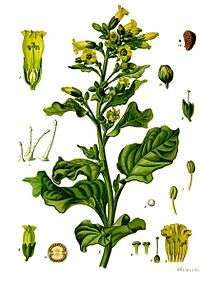Nicotiana rustica
| Nicotiana rustica | |
|---|---|
 | |
| Scientific classification | |
| Kingdom: | Plantae |
| (unranked): | Angiosperms |
| (unranked): | Eudicots |
| (unranked): | Asterids |
| Order: | Solanales |
| Family: | Solanaceae |
| Genus: | Nicotiana |
| Species: | N. rustica |
| Binomial name | |
| Nicotiana rustica L.[1] | |
Nicotiana rustica, Aztec tobacco[2] or wild tobacco,[3] in the sourthern part of México specifically Campeche and Yucatán, it is called Ucuch due to its mayan roots,[4] known in South America as mapacho and in Vietnam as thuoc lao (thuốc lào), is a rainforest plant in the Solanaceae family. It is a very potent variety of tobacco. The high concentration of nicotine in its leaves makes it useful for producing pesticides.
Uses
Nicotiana rustica is often used for entheogenic purposes by South American shamans.[5] It contains up to nine times more nicotine than common species of Nicotiana such as Nicotiana tabacum (common tobacco). Other reasons for its shamanic use are the comparatively high levels of beta-carbolines, including the harmala alkaloids harman and norharman. Most commonly, in South American ethnobotanical preparations, it is allowed to soak or be infused in water, and the water is then insufflated into the stomach in a preparation known as singado or singa; it is also smoked in cigars, used as an enema, made into a lickable product known as ambil, and made into a snuff with the bark of a species of Theobroma, creating nu-nu. In the southeast part of Turkey, people use this herb and ashes of some tree bodies to make a moist snuff called maraş otu. They use this by putting the mixture under their lips like Swedish snus or Afghan naswar. It is also a common admixture of Ayahuasca in some parts of the Amazon.
In Russia, N. rustica is called "makhorka" (махорка). It was smoked rather by the lower classes for such reasons: N.rustica is hardy plant and able to grow on all territory of Russia (as opposed to thermophilic tobacco), it was more available at a price, and did not depend on transport (it was in accordance with underdeveloped road network and climatic portage problems). This was maintained until the ordinary tobacco became widely available (in 20th century). During Soviet times, rustic tobacco was an important industrial crop of agriculture. In those times dozens of varieties were bred, some of them equal by quality to normal tobacco. In modern times, makhorka is still sometimes smoked by peasants and farmers due to its high availability and being almost for free for them.
Nicotiana rustica leaves have a nicotine content as high as 9%, whereas N. tabacum leaves contain about 1 to 3%.[6]
Thuốc lào
In Vietnam, it is most commonly smoked after a meal on a full stomach to "aid in digestion", or along with green tea or local beer (most commonly the cheap "bia hơi"). A "hít" of thuốc lào is followed by a flood of nicotine to the bloodstream inducing strong dizziness that lasts several seconds. It should be said however that even heavy cigarette smokers have had trouble with the intense volume of smoke, the high nicotine content, and that side effects include nausea and vomiting.
The main difference between smoking thuoc lao and the use of other tobaccos is in the method of consumption, in that they are consumed with water pipe. The smoker is presented with either a bamboo pipe called a điếu cày (English: "farmer's pipe") or a ceramic hookah called a điếu bát. It may also occasionally be smoked in a more uncommon pipe known as a điếu ống. The pipe is filled with an appropriate amount of water and a small amount of thuoc lao is pressed into the bowl.

One then ignites the tobacco and inhales to create a body of smoke inside the pipe, before exhaling the smoke, reversing the process of air in the pipe by blowing into it to pop out the tobacco. The smoker then sharply inhales, usually tilting the pipe upwards to an almost horizontal position (but not completely, as the water would drain out the mouth).
Typically, on the streets of Vietnam's capital of Hanoi, a small bag containing enough tobacco for 5 to 8 "hít" retails at 2500 Vietnamese đồng, which is equivalent to about 15 US cents. Larger packs cost up to 20000 đồng and would be about $1.25 US Dollars. The use of thuoc lao is usually out of the bamboo pipe—the điếu cày—which can range from 10000 đồng to upwards of 50000 đồng for items with extravagant carvings and other designs.
Maraş otu
Maraş otu (English: Maraş weed) is chewing variant of Nicotiana rustica. Commonly used by people who live in Maraş. Maraş Otu is mix of Oak tree ash and Nicotiana rustica that resembles henna.[7] It is recognized as a drug by anti-drug activists.[8] It can contribute to mouth cancers.[9]
References
- ↑ "Nicotiana rustica information from NPGS/GRIN". www.ars-grin.gov. Retrieved 2008-03-17.
- ↑ "Nicotiana rustica". Natural Resources Conservation Service PLANTS Database. USDA. Retrieved 20 July 2015.
- ↑ "BSBI List 2007". Botanical Society of Britain and Ireland. Archived from the original (xls) on 2015-02-25. Retrieved 2014-10-17.
- ↑ Translated by Livio III Ceballos García, all credits goes to the quoted website http://www.maya-ethnobotany.org/FLAAR-Reports-Mayan-ethnobotany-Iconography-epigraphy-publications-books-articles-PowerPoint-presentations-course/26_Mayan-ethnobotany-Guatemala-Honduras-El-Salvador-Mexico-Belize-utilitarian-and-sacred-plants-flowers-annual-report-J-2014.pdf
- ↑ "Shamanic Tobaccos". Food of the Gods: The Search for the Original Tree of Knowledge - A Radical History of Plants, Drugs, and Human Evolution. Bantam. 1992. p. 196. ISBN 0-553-37130-4.
- ↑ "Nicotiana sp.". artsci.wustl.edu. Retrieved 2008-03-17.
- ↑ https://eksisozluk.com/maras-otu--141242?p=3
- ↑ http://www.uyusturucu.info.tr/maras_otu.asp
- ↑ http://www.suluyayla.net/?Syf=26&Syz=11481
External links
-
 Media related to Nicotiana rustica at Wikimedia Commons
Media related to Nicotiana rustica at Wikimedia Commons